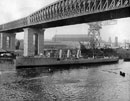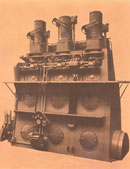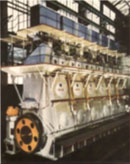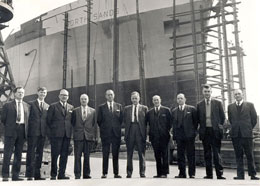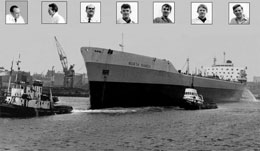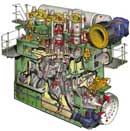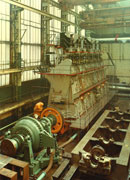 |
|||||||
Doxford Engines 1878 - 1980
Doxford Turret Ships  Triple Expansion Engines Between 1892 and 1911 Doxfords built one hundred and seventy six turret ships. Six more were built by other yards using Doxfords design; Swan Hunter built three, Hawthorn Leslie built one and Vickers built two at Barrow. Most had Doxford triple expansion steam engines fitted. The turret ship design was part of the transition from sail to steam propulsion. The Suez Canal , telegraph, steam power, and steel ships had all recently contributed to a revolution in merchant shipping. The British Empire , the need for British coal to fuel the emerging use of steam as motive power, the world over, helped Britain to exploit the potential of new ship technology. The turret ship arrived at a time when there was need and an opportunity for improved performance of ship and cargo handling. Doxford shipyard and adjoining engine works were ideally placed to benefit doubly from the new design. The Scottish captain Alexander McDougall patented his whale back steamer designed in the late 1880s and built them at his shipyard in Dulluth , Minnesota . With an almost cylindrical hull, and flush hatches they also had raised turrets to support the accommodation and deck machinery. Doxford's ship No. 217, called TURRET was the first turret built by them in 1892. This was followed by a whale back steamer, The SAGAMORE , ship No. 218 under licence from McDougall in 1893. Other shipbuilders offered variations of the turret design. Doxford turrets differed from the whaleback in the style of the turret. The whaleback had individual turrets positioned along the deck, while the Doxford design had one continuous turret. Despite differing in construction the term 'turret' was retained by Doxfords. The ships varied in size from the smallest 691 G.R.T. TURRET HILL, to the largest 7703 G.R.T. QUEDA. 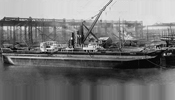 Turret Ship S.S Newbiggin c365 1906 Some controversy surrounds the patent taken out by Doxfords for the ships design. The design was that of Arthur Havers , a chief draughtsman employed by Doxfords. Having presented the design to Doxfords, he proposed to apply for patent rights, only to find that the following day Doxfords had already done so, in their name. Havers took Doxfords to court and was awarded £1,250 for the loss of his patent. His rifts with the company led to him develop the MONITOR ship at Osbourne, Graham & Company at South Hylton , some two miles up-river from Doxfords. A detail account of the Doxford Turret Ships is in a book by Gray & Lingwood, published by the World Ship Society in 1995, ISBN 0 9500044 6 4
When the war ended they resumed work on the four-cylinder engine, and after further research and the completion of successful trials it was felt justified in putting this into production. So in 1921 the engine was installed in the 'Yngaren' this was the first motor ship to be built by Doxfords. From that day on the name of Doxfords became world famous, a total of £100,000 had been spent on developing this new engine. A further five units were built during the 1920-23 depression.
During World War Two they turned their whole production over to a three-cylinder 2,500 bhp unit. It later earned the title of 'the economical'; because of its low fuel consumption, only six tons a day. Ships with heavy loads had to run this engine at or near to its limiting rpm to keep up with a convoy in the North Atlantic. In spite of this abuse, they remained remarkably reliable. It remained in production after the war.
Early problems tackled by Mr. Jackson were with the turbo-charging and the Doxford engine common rail system of airless-injection had been most efficient. Jackson set about retaining the high economy of the original arrangement while achieving greater simplicity and lower costs. This he did with no great expenditure of time or money and not without departing drastically from what Doxford customers knew and liked, a very important consideration in marine engineering. THE DOXFORD 'P' ENGINE
The new engine eliminated some of the design elaboration, of the original (LB) type, it saved on length and had a stiffer crankshaft. Percy Jackson was able to offer Doxford engines with appreciably higher power than had been thought possible, although six cylinders were regarded as the upper limit. The design was a success and gave great satisfaction to a lot of owners.
Though the development of the 'P' engine was successful, the demand for increased power had continued. Once again the Doxford engine was feeling the keen competition. The fact was that it could not compete in the big single-screw diesel engine business. So once again in 1962 Percy Jackson demonstrated his resourcefulness. The result was the quickly designed and rapidly developed the 'J' type Doxford engine. By adopting disc-type crank webs and using them as main bearings that proved in prolonged testing the Doxford has acquired a fundamental ability to cope with very much higher powers than was thought achievable. The general design was clever and simple and the final result was a high-powered marine oil engine that was keenly competitive. Doxfords consider it to be the lightest engine of its type The Doxford-Hawthorn Seahorse Engine A milestone in Doxford engine technical development was the design, construction and testing of the Seahorse prototype medium speed engine between 1970 and 1975. This was a joint venture between Doxford's and Hawthorn Leslie (Engineers) Ltd of Tyneside. It was intended to offer the marine market a crosshead engine, with its associated robustness and ability to burn The Doxford 58JS3 Engine
Design work on the 58JS engine began in the autumn of 1976. Among the people at Doxford's who were responsible for the concept and development of the 58JS design were Frank Butler, Henry Henshall, George Jackson, Finn Ørbeck, David Stables and Brian Taylor. Along with many other people, working on the detail design of the components.
Construction began in 1977, and the first engine completed its test-bed trials in 1978. Seven of the ten engines were supplied to ships. These vessels were equipped for unmanned engine room operation, and they represented the first application of microprocessor systems to the automatic control of slow-running marine oil engines. Of the seven ships equipped with 58JS engines five still appeared in the Lloyds register, 2002-2003 edition. The last engine built at Doxfords in 1980 was a 76JC4R. It was fitted in the ship "Canadian Pioneer" which was built in Canada. This vessel is now named "M.V.PIONEER" and is owned by MARBULK CANADA INCORPORATED and managed by V-SHIPS U.K. LIMITED.
|
|||||||

